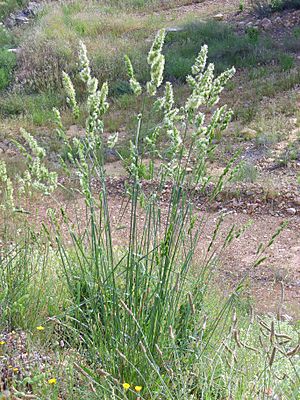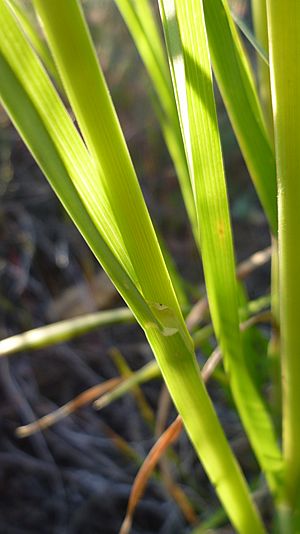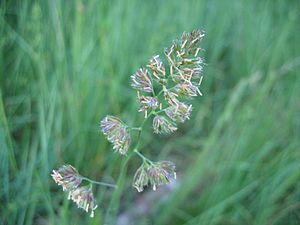Dactylis glomerata facts for kids
Quick facts for kids Dactylis glomerata |
|
|---|---|
 |
|
| Scientific classification | |
| Genus: |
Dactylis
|
| Species: |
glomerata
|
Dactylis glomerata, also known as cock's-foot grass, orchard grass, or cat grass, is a very common type of grass. It gets the name "cat grass" because many domestic cats enjoy chewing on it! This grass is a cool-season plant that grows in clumps. It is found naturally across most of Europe, parts of Asia, and northern Africa.
Contents
Where Does Cock's-foot Grass Grow?
Cock's-foot grass can be found in many places. It grows from sea level up to very high mountains, like 4,000 meters (about 13,000 feet) in Pakistan. People often grow it to make hay and as food for farm animals.
You can spot this grass in meadows, pastures, along roadsides, and in wild, grassy areas. It is very common in the United Kingdom.
This grass has also been brought to places like North America, New Zealand, and Australia. Now, it grows widely there, almost like it's native. In some areas, it has become an invasive species, meaning it grows so much that it can take over and harm other plants.
What Does Cock's-foot Grass Look Like?
Cock's-foot grass grows in thick clumps called "tussocks." It can reach a height of 20 to 140 centimeters (about 8 inches to 4.5 feet). Its leaves are grey-green and can be 20 to 50 centimeters (about 8 to 20 inches) long.
One special thing about this grass is its unique flower head. It looks like a tufted triangle and can be 10 to 50 centimeters (about 4 to 20 inches) long. The flower head might be green or have a reddish-purple color, especially when it gets a lot of sun. As the seeds ripen, it turns a pale grey-brown.
The small flower parts, called spikelets, are 5 to 9 millimeters long. Each spikelet usually has two to five flowers. Another key feature is its flattened stem base, which helps tell it apart from other grasses. This grass usually flowers from June to September.
Different Types of Cock's-foot Grass
Scientists sometimes group Dactylis glomerata as the only species in its group. Other times, they include a few more species. It is often divided into different types, called subspecies, based on where they grow. Here are some examples:
- Dactylis glomerata subsp. glomerata: Found widely, first described in Europe.
- Dactylis glomerata subsp. hispanica: Grows in the Mediterranean region and Southwest Asia.
- Dactylis glomerata subsp. lobata: Found in Central Europe.
- Dactylis glomerata subsp. marina: Grows in the western Mediterranean and Canary Islands.
Some of these subspecies have different numbers of chromosomes. For example, Dactylis glomerata subsp. glomerata and subsp. hispanica are "tetraploid," meaning they have four sets of chromosomes (28 in total). Other types, like subsp. lobata, are "diploid," with two sets of chromosomes (14 in total). The tetraploid forms are generally larger than the diploid forms.
Why is Cock's-foot Grass Important?
Cock's-foot grass is very useful for farming. It is widely grown for hay and for feeding animals in pastures. This is because it produces a lot of grass and has a high sugar content, which makes it sweeter than many other grasses. In dry areas, like parts of Australia, people prefer the Mediterranean types because they can handle drought better.
However, if animals don't graze on it enough, it can become tough and less tasty for them. In some places where it has been introduced, cock's-foot grass has become an invasive species. This means it grows too much and can harm local plants.
Like pollen from other grasses, the pollen from cock's-foot can cause hay fever (allergic rhinitis) in some people. This is when your nose gets runny and itchy because of an allergy to pollen.
As mentioned, this grass is also popular as "cat grass" because many domestic cats love to chew on it.
Butterflies and Cock's-foot Grass
Many butterfly caterpillars use cock's-foot grass as their food plant. This means the caterpillars eat the grass to grow and develop. Some of these butterflies include:
- Meadow brown (Maniola jurtina)
- Wall brown (Lasiommata megera)
- Gatekeeper (Pyronia tithonus)
- Large skipper (Ochlodes venata)
- Essex skipper (Thymelicus lineola)
- Small skipper (Thymelicus sylvestris)
- Zabulon skipper (Poanes zabulon)
- Speckled wood (Pararge aegeria)
See also
 In Spanish: Dáctilo o pasto ovillo para niños
In Spanish: Dáctilo o pasto ovillo para niños




